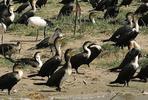Cormorants
© Cormorant © Graham Cooke
Appearance
Because of their black colouration, Cormorants are often referred to as sea crows. In fact, the family name, Phalacrocoracidae, means bald raven in Greek. While Cormorants do appear black, close inspection reveals that they are, in fact, a variety of dark colours ranging from green and violet to ultramarine and bronze. In breeding plumage, these large seabirds have intensely bright patches, which occur in a variety of specific colours, around their eyes and throat. Cormorants possess a gular sac, or throat pouch, that has a variety functions.
It acts as a holding area for larger prey, helps the bird rid itself of extra heat while panting, and in the breeding season, the bright colours of the pouch are used for display during courtship. Ranging from 63 to 101 cm in length, these water birds have distinctive long, slender, hooked bills. Although their large feet make these birds exceptional swimmers, they are not elegant walkers.
Often, the feet overlap and their clumsiness has led to many broken eggs. The structural characteristics that make cormorants such excellent swimmers, also affects their flying ability. The massive thigh and hip muscles that gives them strong underwater propulsion make them heavy in relation to the surface area of their wings. It is these characteristics that keep these large birds close to their roosts; they do not venture too far out to sea.
Diet
Found in both fresh and salt water, their diet consists mostly of fish, but small amphibians and crustaceans are also consumed.
Breeding
Nesting 3-5 chalky, pale blue-green eggs in a well-made platform of sticks, or of seaweed on the coast, placed in a tree or on a cliff or rocky island. They cement the nests together with guano and will often use the same nest again. Nests in colonies.
Behaviour
Despite spending much time in the water, they do not possess the waterproofing oil of other seabirds and so must spend much time drying their wings. Cormorants used traditional sites for roosting and nesting, and the droppings at these sites can build up for years. Clumsy on land, cormorants form colonies at sites that are safe from mammalian predators. Sometimes these are on offshore islets or steep cliffs, but others build nests (or use old heron nests) in bare dead trees standing in water or perched on inaccessible cliffs.
Habitat
Lakes, rivers, swamps, and coasts.
Where Cormorants Are Found
Cormorants are found almost everywhere that water meets shore.
Latin name
Phalacrocoracidae.

